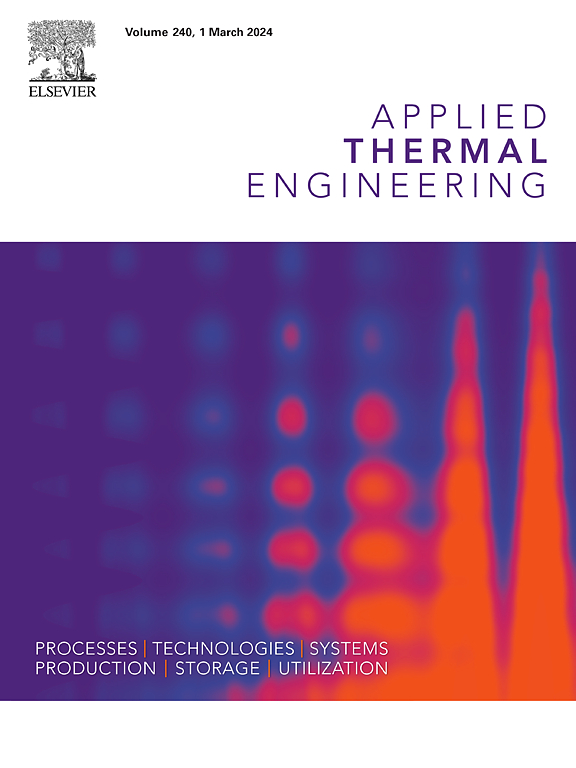Vapor separation in minichannel heat sink flow boiling application using gradient porous copper ribs
IF 6.1
2区 工程技术
Q2 ENERGY & FUELS
引用次数: 0
Abstract
The accumulation of a significant amount of vapor in minichannels severely limits their flow boiling heat transfer performance, posing a challenge for efficient thermal management in high-power electronic devices. To address this issue, we propose an innovative gradient porous copper rib minichannel with a vapor separation function. This design incorporates micro-pore porous copper and open-cell porous copper, where the unique structure of the micro-pore porous copper is crucial for achieving effective vapor separation. This innovative design not only expands the vapor discharge pathways within the minichannel but also significantly enhances the overall efficiency of vapor removal. Using water as the working fluid, flow boiling experiments were conducted across a range of mass fluxes (G = 26.1 kg/(m2s) ∼ 156.9 kg/(m2s)) and heat fluxes (qeff = 38.2 kW/m2 ∼ 267.5 kW/m2). The experimental results demonstrate that vapor separation significantly alleviates backflow and enhances heat transfer performance. Specifically, our findings indicate that the average temperature of the heat transfer surface decreases by 0 to 10 °C, while the maximum heat transfer coefficient increases by 2.3 times compared to conventional designs. This work presents a practical and innovative approach to mitigating vapor accumulation in minichannels, providing valuable insights for the design of high-performance minichannel heat sinks.
利用梯度多孔铜肋条在微型通道散热器流沸腾应用中进行蒸汽分离
微型通道中大量蒸汽的积聚严重限制了其流动沸腾传热性能,给大功率电子设备的高效热管理带来了挑战。为解决这一问题,我们提出了一种具有蒸汽分离功能的创新型梯度多孔铜肋微型通道。这种设计结合了微孔多孔铜和开孔多孔铜,其中微孔多孔铜的独特结构对于实现有效的蒸汽分离至关重要。这种创新设计不仅扩大了微型通道内的蒸汽排放途径,还显著提高了蒸汽去除的整体效率。以水为工作流体,在一系列质量通量(G = 26.1 kg/(m2s) ∼ 156.9 kg/(m2s))和热通量(qeff = 38.2 kW/m2 ∼ 267.5 kW/m2)范围内进行了流动沸腾实验。实验结果表明,汽水分离大大缓解了回流现象,提高了传热性能。具体而言,我们的研究结果表明,与传统设计相比,传热表面的平均温度降低了 0 到 10 °C,而最大传热系数则提高了 2.3 倍。这项研究提出了一种实用的创新方法来缓解微型通道中的蒸汽积聚,为高性能微型通道散热器的设计提供了宝贵的启示。
本文章由计算机程序翻译,如有差异,请以英文原文为准。
求助全文
约1分钟内获得全文
求助全文
来源期刊

Applied Thermal Engineering
工程技术-工程:机械
CiteScore
11.30
自引率
15.60%
发文量
1474
审稿时长
57 days
期刊介绍:
Applied Thermal Engineering disseminates novel research related to the design, development and demonstration of components, devices, equipment, technologies and systems involving thermal processes for the production, storage, utilization and conservation of energy, with a focus on engineering application.
The journal publishes high-quality and high-impact Original Research Articles, Review Articles, Short Communications and Letters to the Editor on cutting-edge innovations in research, and recent advances or issues of interest to the thermal engineering community.
 求助内容:
求助内容: 应助结果提醒方式:
应助结果提醒方式:


